Surge protector failure safety protection role - Database & Sql Blog Articles
First, the cause analysis of the failure of the surge protector:
1. Surge damage accumulates to a certain extent causing failure (aging)
2. Exceeding the current limit (instantaneous overcurrent) that the surge suppression component can withstand
3. The short-term overvoltage exceeds the maximum continuous operating voltage that the surge suppression component can withstand: MCOV (transient overvoltage)
Second, why the surge protector must be fault-protected When the suppressor element (MOV) in the surge protector is broken down, the faulty component is in a short-circuit condition, which will seriously affect the power distribution system. The short-circuit current flows from the power distribution system to the failed surge protector, causing the component to heat up quickly and burn, or even burst into pieces. Therefore, a suitable separation device must be provided to separate the failed component from the power distribution system.
3. Classification of separation devices for fault protection of surge protectors 1. Classification by performance: overcurrent protection, overheat protection 2. Classified according to the nature of the device: fuse, circuit breaker 3. Classified according to the set position: built-in, external 4. Classification of the number of built-in fuses: product level, component group level, component level (only multi-element protector has this classification)
Fourth, the actual protection of the surge protector protection 1. Over-current protection can be achieved by adding an air switch/circuit breaker upstream, but the open response time is slow and there is a coupling problem, which is the simplest but far from ideal;
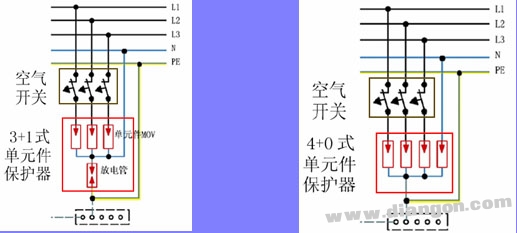
2. The circuit breaker with the fuse on the upstream can realize the overcurrent protection, and the effect is better than the air switch; the position of the circuit breaker should not be too far from the protector;
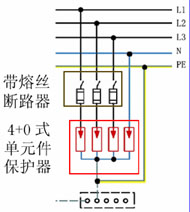
3. Use a protector with built-in fuse: (unit product)
Can achieve overcurrent protection
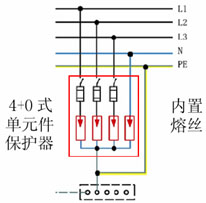
Specific application: a fuse is set on the LN of the single-phase product; a fuse is set on the three-phase product L1/L2/L3-N, and some domestic European brand products have such a setting, and the single-piece product is currently available on the market. See the best way to protect your faults.
(Unit protector: only one surge suppression component per mode)
4. Use a protector with built-in fuse: fuse level is product grade (for multi-component products only)
It can realize over-current protection, and the product has certain stability. Multiple components (such as 6) connected in parallel to a specific protection mode (such as LN), and a fuse is set in each group;
Some IEEE standard imported products adopt this method
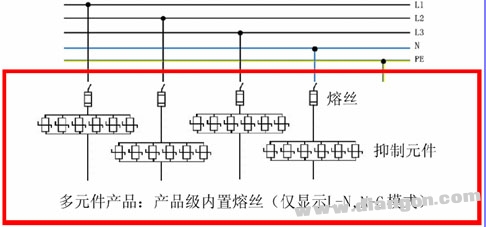
5. Use a protector with built-in fuses: fuses are on the order of component groups (only for multi-component products)
Can achieve overcurrent protection, the product has good stability (depending on the component size and grouping ratio)
Grouping multiple components (such as 6) in parallel on a specific protection mode (such as LN), grouping the components (for example, into 2 groups), and setting a fuse on each group;
Some IEEE standard imported products adopt this method
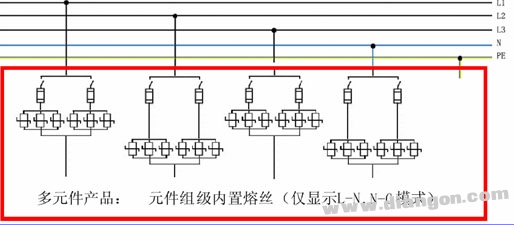
6. Use a protector with built-in fuse: fuse level is component level (only for multi-component products)
Overcurrent protection is achieved, and the product has high stability. For each component connected in parallel on a specific protection mode (such as LN), a separate fuse is designed for each component in this mode.
At present, only high-end IEEE standard imported products adopt this method.

7. Use a protector with built-in fuse: fuse level is component-level double fault protection (only for multi-component products)
Overcurrent and overheat protection can be realized at the same time: Under the condition of ensuring safety, the product has high stability and can adapt to various possible fault problems. It is the highest level of fault protection to date.
For a plurality of components connected in parallel on a specific protection mode (such as LN), two fuses are connected in series in front of each component in this mode to achieve overcurrent protection and overheat protection respectively; Avoid suppressing the component from exploding in the event of a fault.
At present, only the highest-end IEEE standard imported products adopt this method, such as the US-made JOSLYN protector.
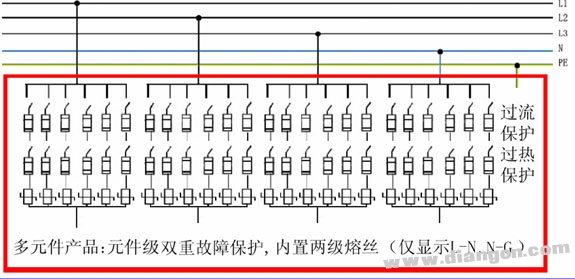
5. The meaning of the fail-safe protection inside the surge protector 1. Ensure that the protector and all internal components are safely operated during operation and that the faulty part is safely separated in the event of a fault;
2. In any case, the protector is completely free of pollution to the surrounding environment, does not emit smoke, does not burn, and does not explode.
3. The comprehensive requirements for fault protection should be: under any conditions, it will not cause damage to other loads, the surrounding environment and life safety.
Sixth, multi-component products to achieve component isolation method If the protector shell reaches a certain level of protection, such as IP65, it can be considered that the internal component failure caused by pollutants (smoke, flame, burst debris) is limited to the inside of the casing, so that the peripheral equipment does not Affected. However, if it is to ensure that the internal components do not affect other internal components and circuits in the event of a fault, this requires good isolation between the internal components, especially for multi-component products.
The isolation of internal components requires solving the following two problems:
1. On the one hand, it plays the role of fixing the internal structure and components of the protector, improving the anti-seismic and anti-stretching ability of the product;
2. On the other hand, it is necessary to be able to have a sufficient space for release of a component in the event of a fault, and to limit the pollutants (soot, flame, bursting debris) generated during release to a certain extent, thereby ensuring the peripheral portion of the faulty component. Not affected.
In fact, it is not easy to do the above two aspects. Let us introduce the specific application in the real situation:
1. Almost all domestic protectors, including European brands of domestic protectors, have avoided this problem. The specific situation is generally: IP20, unit design, no component isolation measures are taken internally;
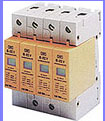
Effect: Poor seal, product anti-shock, anti-fall ability is limited, affected by the external environment (such as: high altitude, dust, fungi, corrosive gases, etc.), can not adapt to outdoor installation; because the external protection level is only 20, suffer It may crack when a large current strikes.
2. Multi-component products are internally sealed with epoxy and fully fixed;
advantage:
-- Improved the seismic and anti-fall ability of the protector;
-- may increase the degree of protection of the protector to IP66;
-- can protect the protector from external influences and work around the clock;
-- Conducive to the cooling of the internal components after heating;
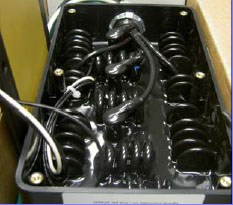
Disadvantages:
-- When subjected to a vicious shock, a violent explosion may occur;
Specifically, if the Imax of the protector is 120kA. When such products are subjected to shocks exceeding their Imax, multiple internal components may be broken down and burst. At this time, since the component is sealed by the hard epoxy, the hot gas generated by the explosion has no space to be released, so the internal faulty components only burst together with the sealed epoxy to complete the release, but this collapsed release The consequences can be unimaginable.
Summary: This type of isolation is ideal when the product does not suffer from the malignant impact of its Imax. However, there is a major safety hazard in this type of isolation for possible malignant impacts.
3. Multi-component products are internally sand-filled: about 80% of the interior is filled with sand-like particles (such as quartz sand): Avoiding the safety hazard of “epoxide sealingâ€
-- It can better improve the shock and fall resistance of the protector, but it is not as good as "epoxide seal";
-- Better protects the protector from external influences, working around the clock, but not as good as "epoxide seal";
-- Can effectively help the internal components cool down after heating;
-- When the protector is subjected to a malignant impact, the impact force of the faulty component can be reliably eliminated, and the arc generated during the splitting can be eliminated, so that the hot gas can be released with low intensity and rapidly cooled;
4. Multi-component products are internally filled with elastic colloids: 80% of the interior is filled with elastic colloids. Evaluation: The best component isolation method so far
-- It can improve the anti-seismic and anti-fall ability of the protector;
-- Good protection of the protector from external influences, working around the clock;
-- It can very effectively help the internal components cool down after heating;
-- When the protector is subjected to a malignant impact, the impact force of the faulty component can be reliably eliminated, and the arc generated during the splitting can be eliminated, so that the hot gas can be released with low intensity and rapidly cooled;
Seven, the relationship between component separation, isolation measures and protector stability: the problem of multi-component products
1. The more components connected in parallel in a particular mode, the more stable and reliable under normal operating conditions;
2. The more fuses are set in a particular mode, the more it can improve the survivability of the protector under fault conditions, and the ability to adapt the protector to a harsh power distribution environment with continuous large surge current surges;
3. The better the isolation between components, the more the number of protectors connected in parallel in a particular mode;
4. The two-stage fuse is set to increase the overheat protection, which can well prevent the internal suppression component from bursting in the event of failure;
5. The more methods implemented, the higher the quantity level and the higher the product cost;
Conclusion: Choose the most suitable product between “fault-free protection design†and “component-level double fault protection plus elastic colloid isolation†from a single-unit protector with no separation device, no internal component isolation, to a component-level dual separation device. And there is a big gap between the multi-component products with elastic colloid isolation, and many grades can be divided in the middle; for the end user or engineering designer who uses the surge protector, it is recommended to select the protector on the one hand. Understand what kind of fault protection design is adopted by the selected protector, and the other side should also understand the specific conditions of the use environment (humidity, altitude, pollution degree, flammability and explosive degree, own distribution environment, lightning strike) according to their actual needs. Probability, power requirements of connected equipment, failure rate, operation and maintenance cost, and cost of downtime, etc., take into account various factors to select the most suitable product.
90W Medical Adapter,5V Medical Power Adapter,90W Medical Outlet Adapter,Medical Grade Power Adapter Stanstards
Shenzhen Longxc Power Supply Co., Ltd , https://www.longxcpower.com